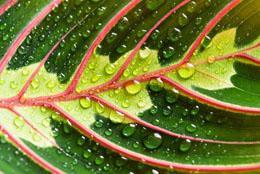Beautifully patterned leaves are one of the distinguishing features of the prayer plant. Let us take a look at tips that will help you care for the plant.

Prayer plants are popular houseplants which are easy to grow. The botanical name is
Maranta leuconeura. It is a potted plant that has the ability to spread. It is popular because of its beautiful, colored as well as patterned leaves. Its name comes from its unique characteristic wherein it tends to close its 3 to 5-inch broad leaves in the evening, and fold it completely by night. This gives the leaves the appearance of hands that are folded in prayer. The leaves open again in daytime.
Caring Instructions
These plants have specific needs that need to be catered to. They thrive in areas that have bright, indirect sunlight and tend to droop in low-light conditions. If the light is too bright though, the color of the leaves will fade. If the leaves remain folded even in daytime, it indicates lack of enough light. They need well-drained soil which should be moist but not too wet or soggy. The pH of the soil should be slightly acidic. The temperature should be maintained at 65 to 85ºF. Do not place the plants near air vents, as they cannot handle frequent changes in temperature.
Maintain light and humid conditions for the plant to thrive. They should be fertilized with water-soluble fertilizers every two weeks. If you are growing the plants in containers, then the container needs to be wider than it is taller. This is important as the roots of the plants are shallow and, therefore, they tend to spread. We suggest that you plant them in a wide pot made of either wood or plastic. Clay pots should be avoided as they absorb water. It is important that you repot the plants every spring. Mix two parts of peat moss with one part loam and one part perlite and use this mixture while replanting.
Flowers
The flowers of this plant are white, blue, or pink in color. These tiny flowers bloom over a slender stem many inches above the leaves. If you want your plant to flower, you should avoid repotting. This is because the plant tends to focus its energy trying to reestablish its roots in the new soil. While the number of flowers on the plant are few, they are beautiful to look at.
Propagation
If you have a healthy plant that you can use for propagation, then all you need to do is bring home a container with a draining hole and fill it up with potting soil. Then, select a leaf, from the plant that you have, which is healthy and shows no signs of drooping or wilting. Cut the stem from the lower nodules and make a small cut just below the leaf. Now, dip the stem cutting in a rooting hormone. Place the stem in the potting soil and tap down the soil gently. You can plant more than one stem with leaves. Just make sure the leaves do not crowd as they will rot otherwise.
Cover the pot with a plastic bag and secure it with a rubber band. Make sure the condition within the bag remains moist. You can remove the bad leaves and spray the soil with water when you notice that the soil is dry. The pot should be kept in a warm place which receives indirect sunlight. Within 2 to 3 weeks the roots will develop and when the roots are 1-inch long, you can transfer the cuttings to a bigger container. Fertilize it once every month.
Toxicity
Those who are planning to grow this plant for the first time often wonder about toxicity. This concern is especially not unfounded if you have kids or pets at home. The plant is a non-toxic plant and is not known to be poisonous in any way. The American Association of Poison Control Center has found these plants to be totally safe and non-toxic. Even the American Society for the Prevention of Cruelty to Animals states that the plant is non-toxic and non-poisonous for felines and canines.
Just ensure that you provide proper light and temperature conditions and see these plants flourish. Their broad, colorful leaves make them popular office plants too. Completely safe and non-toxic, you will enjoy planting these in your home.






 Prayer plants are popular houseplants which are easy to grow. The botanical name is Maranta leuconeura. It is a potted plant that has the ability to spread. It is popular because of its beautiful, colored as well as patterned leaves. Its name comes from its unique characteristic wherein it tends to close its 3 to 5-inch broad leaves in the evening, and fold it completely by night. This gives the leaves the appearance of hands that are folded in prayer. The leaves open again in daytime.
Prayer plants are popular houseplants which are easy to grow. The botanical name is Maranta leuconeura. It is a potted plant that has the ability to spread. It is popular because of its beautiful, colored as well as patterned leaves. Its name comes from its unique characteristic wherein it tends to close its 3 to 5-inch broad leaves in the evening, and fold it completely by night. This gives the leaves the appearance of hands that are folded in prayer. The leaves open again in daytime.